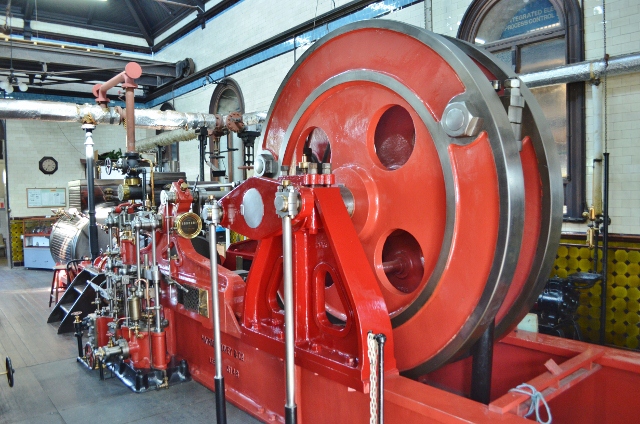Hathorn Davey on:
[Wikipedia]
[Google]
[Amazon]
 Hathorn Davey was a British manufacturer of steam engines, based in
Hathorn Davey was a British manufacturer of steam engines, based in
 This was one of their more successful engines. Patented in 1871, a company brochure lists 46 examples of these large engines built up to 1906. The leaflet also gives 32 examples where a smaller version of this engine was installed underground. The differential was a small engine resembling a boiler feed pump which was used to control the speed of the larger engine.
Davey pumps were also installed in Japan, for example at Manda coal mine in 1876. The nearby ''Onga River Pumping Station'' of
This was one of their more successful engines. Patented in 1871, a company brochure lists 46 examples of these large engines built up to 1906. The leaflet also gives 32 examples where a smaller version of this engine was installed underground. The differential was a small engine resembling a boiler feed pump which was used to control the speed of the larger engine.
Davey pumps were also installed in Japan, for example at Manda coal mine in 1876. The nearby ''Onga River Pumping Station'' of

London Museum of Water and Steam
Grace's Guide
Melbourne museum
Cambridge Museum of Technology
* ttp://www.dmm.org.uk/transime/u17d-01.htm Detailed account of Stank and Yarlside pumps in 1899 by Jas Davison for the IME.
Inside of Violet pit engine house showing the differential engine.
Sun foundry
{{Authority control Steam engine manufacturers Manufacturing companies based in Leeds Defunct companies based in Leeds Defunct engineering companies of England
 Hathorn Davey was a British manufacturer of steam engines, based in
Hathorn Davey was a British manufacturer of steam engines, based in Leeds
Leeds () is a city and the administrative centre of the City of Leeds district in West Yorkshire, England. It is built around the River Aire and is in the eastern foothills of the Pennines. It is also the third-largest settlement (by populati ...
. The Sun foundry was established in 1846 and made railway engines and pumping machinery until 1870. The premises were taken over in 1872 by Hugh Campbel, Alfred Davis and John Hathorn. They were joined by Henry Davey in 1873 and traded as Hathorn, Davey & Co from 1880. The partnership was converted to a limited company in 1901. They made marine engines and pumps as well as their pumping engines for mines and waterworks. The pumping engine built for the Mersey tunnel in 1881 was described at the time as the most powerful in existence. The firm was taken over by Sulzers in 1936. The premises closed in late 1981 when Sulzers moved to a new site.
The horizontal compound differential pumping engine
 This was one of their more successful engines. Patented in 1871, a company brochure lists 46 examples of these large engines built up to 1906. The leaflet also gives 32 examples where a smaller version of this engine was installed underground. The differential was a small engine resembling a boiler feed pump which was used to control the speed of the larger engine.
Davey pumps were also installed in Japan, for example at Manda coal mine in 1876. The nearby ''Onga River Pumping Station'' of
This was one of their more successful engines. Patented in 1871, a company brochure lists 46 examples of these large engines built up to 1906. The leaflet also gives 32 examples where a smaller version of this engine was installed underground. The differential was a small engine resembling a boiler feed pump which was used to control the speed of the larger engine.
Davey pumps were also installed in Japan, for example at Manda coal mine in 1876. The nearby ''Onga River Pumping Station'' of Yawata Steel Works
The is a steel mill in Kitakyūshū, Fukuoka Prefecture, Japan. Imperial Steel Works was established in 1896 to meet increasing demand from the nation's burgeoning shipbuilding, railway, construction, and armaments industries. The site chosen ...
also received a steam pump from Davey.
The largest concentration of this design was at the Tasmania Gold Mining Co's Beaconsfield
Beaconsfield ( ) is a market town and civil parish within the unitary authority of Buckinghamshire, England, west-northwest of central London and south-southeast of Aylesbury. Three other towns are within : Gerrards Cross, Amersham and High W ...
mine where three engines were assembled. Each had cylinders of and diameter and raised 100,000 gallons of water per hour from Each engine drove two pumprods, each weighing 170 tons and driving 6 pumps. Beaconsfield mine closed in 1914 when the pumps were overwhelmed and re-opened in 1999. At least 7 of these engines were used in the Furness iron mines, 3 at Yarlside and the remainder at Harrison Ainslie
The firm of Harrison Ainslie & Co. was a British firm of ironmasters and iron ore merchants, selling high quality haematite from their mines on Lindal Moor to smelters in Glasgow, Scotland, South Wales and the Midlands. From a 21st-century persp ...
's pits.McFazdean, Alen The Iron Moor, Red Earth Publications, 1989 There is a surviving example at Cambridge Museum of Technology
The Cambridge Museum of Technology is an industrial heritage museum situated in Cambridge, England. The original building, a Scheduled Ancient Monument,
housed a combined sewage pumping and waste destructor station built in 1894. The Museum h ...
.
References
External links

London Museum of Water and Steam
Grace's Guide
Melbourne museum
Cambridge Museum of Technology
* ttp://www.dmm.org.uk/transime/u17d-01.htm Detailed account of Stank and Yarlside pumps in 1899 by Jas Davison for the IME.
Inside of Violet pit engine house showing the differential engine.
Sun foundry
{{Authority control Steam engine manufacturers Manufacturing companies based in Leeds Defunct companies based in Leeds Defunct engineering companies of England